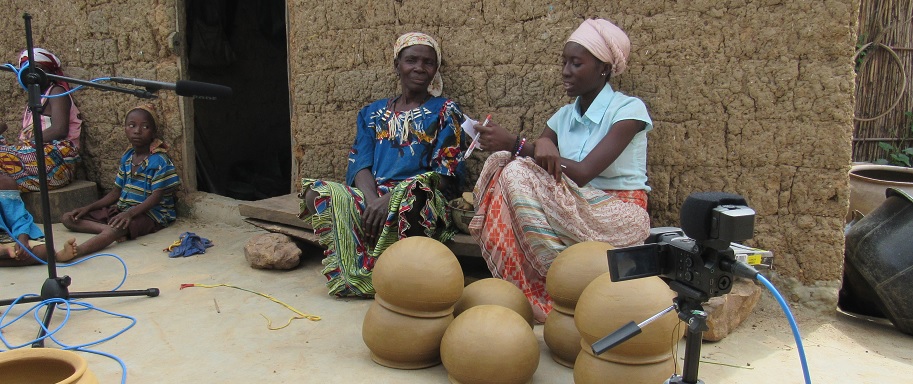
About Me
I am a community-based researcher with interests in phonological description, analysis and theory, syntax-phonology interface and phonetics. I have deep experience doing community-based research on endangered and under-resourced African languages. My approach to linguistic research involves considering language-external evidence for linguistic theory, so my research also focuses on language-music connections (e.g., talking drums) and language-based cultural aesthetics.
Coupled with phonological description and analysis of understudied languages, my research uses newer instrumental methods (e.g ultrasound tongue imaging), statistical models and data visualisation techniques to investigate details about phonetic properties of sounds that were not possible to capture through older impressionistic observation methods.Research Highlights
My primary research focuses on how the structural components of real-world events and entities influence phonological grammar. The empirical basis for this exploration largely comes from phonological alternations motivated by iconicity—that is, the perceived resemblance between form and meaning. My research on these alternations extends beyond prosaic word classes (i.e., non-expressive verbs, nouns, adjectives, and adverbs) to include ideophones, a class of words in which form–meaning mappings are often rooted in iconicity. I explore the implications of these phonological patterns for linguistic theory, particularly with respect to the view that the source of linguistic knowledge and representation is a language-specific cognitive capacity and that iconicity plays no significant role in grammar.
My secondary research area is sound-meaning mapping in language and language-external sources, as well as other metalinguistic knowledge rooted in the traditional intellectual traditions of the language. As language-external evidence for iconicity or resemblance-based mapping in general, I investigate prominent examples of sound-meaning mapping in language-based verbal arts and music, such as the talking-drum languages of West Africa. In talking-drum systems and other speech surrogates, musicians map linguistic meaning to music melodies by imitating linguistic features with musical instruments. Speech surrogates do not only serve as language external evidence for linguistic theory but afford us the opportunity to investigate language in other modes of communication. While previous studies on speech surrogates have tended to focus more on musical imitation of language, my research also examine the “opposite”, which involves verbal imitation or interpretation of music melodies.Data source: Grammaticalized iconicity and form-meaning mapping in music are underdocumented, a key component of my research is the documentation and description of language, with a specific focus on endangered and understudied African languages. Why are endangered and understudied languages worth studying? Research on endangered and understudied language are expanding our knowledge of human cognition, which is based on sampling those languages currently spoken. If the number of languages spoken shrinks considerably, this will affect the validity of many of our observations about what human beings are capable of in a domain as central to us as language. The openly accessible corpora, which are created from the results of my community-based research on these languages, serve as resources to the linguistic community.
Peer-reviewed papers
Akinbo, Samuel (2025). Iconicity of grammatical tonal polarity and reduplication in Nigerian Pidgin. Journal of Linguistics, 10(1), 20240013.
Akinbo, Samuel & Philip Oghenesuowho Ekiugbo (2024). Iconicity as the motivation for morphophonological metathesis and truncation in Nigerian Pidgin. Open Linguistics, 10(1), 20240013.
Akinbo, Samuel, Avery Ozburn, Gerald Nweya & Douglas Pulleyblank (2023). Eleven vowels of Imilike Igbo including ATR and RTR schwa. Journal of International Phonetic Association, 1-24.
Ozburn, Avery and Canavesi, Gianna F Giovio and Akinbo, Samuel. (2023). Perception of ATR in Dàgáárè. Laboratory Phonology, 14(1).
Akinbo, Samuel. (2023). Sound-Meaning Mapping: Verbal imitation of Super Mario Music by Yorùbá Gamers. Language Sciences, 98
Akinbo, Samuel. (2023). Reduplication, repetition and sound symbolism in Fungwa. Phonological Data Analysis.
Akinbo, Samuel Kayode, Olanrewaju Samuel, Iyabo Alaga & Olawale Akingbade. (2022). An acoustic study of vocal expression in two genres of Yoruba oral poetry. Frontiers in Communication, 271
Akinbo, Samuel. (2021). Featural affixation and sound symbolism in Fungwa. Phonology 38, 537–569.
Akinbo, Samuel. (2021). The Language of Gángan, A Yorùbá Talking Drum. Frontiers in Communication, 180.
Angsongna, Alexander & Akinbo, Samuel. (2020). Dàgáárè (Central). Journal of the International Phonetic Association, 1-27.
Akinbo, Samuel. (2019). Representation of Yorùbá Tones by a Talking Drum: An Acoustic Analysis. Linguistique et Langues Africaines, 5, 11-23.
Lewis, Demola & Akinbo, Samuel. (2014). EEG cerebral localization of tone. Journal of West African Languages XLI, 2, 118.
Proceedings and book chapters
Akinbo, Samuel, Alexander Angsongna, Avery Ozburn, Murray Schellenberg & Douglas Pulleyblank. Languages XLI, 2, 118.
(2019). Velar Tap in Dàgáárè. Annual Conference on African Linguistics (ACAL 49). Michigan.
Akinbo, Samuel. (2019). Minimality and Onset Conditions Interact with Vowel Harmony in Fungwa. Proceedings of the Annual Meeting on Phonology 2018.
Ozburn, Avery, Samuel Akinbo, Alexander Angsongna, Murray Schellenberg & Douglas Pulleyblank. (2019). Dagaare [a] Is Not Neutral To ATR Harmony. Canadian Acoustics, 46(4), 36-37.
Keough, Meagan, Avery Ozburn, Elise McClay, Michael Schwan, Murray Schellenberg, Samuel Akinbo & Bryan Gick. (2015). Acoustic and articulatory qualities of smiled speech. Canadian Acoustics, 43(3).
Unpublished Manuscripts and material
Akinbo, Samuel. (2021). Vowel harmony and some related processes in Fungwa (Doctoral dissertation, University of British Columbia).
Akinbo, Samuel. (submitted). Morphophonological Exchange and Grammaticalised Sound Symbolism in Naijá, aka Nigerian Pidgin. Natural Language & Linguistic Theory.
Akinbo, Samuel, Avery Ozburn, Alexander Angsongna, Angelina Lloy & Douglas Pulleyblank. (submitted). Phonetics and Phonology of ATR harmony in Dàgáárè Phonetica
Akinbo, Samuel. (in prep). Sound Symbolism in Core Grammar of Naijá, aka Nigerian Pidgin.